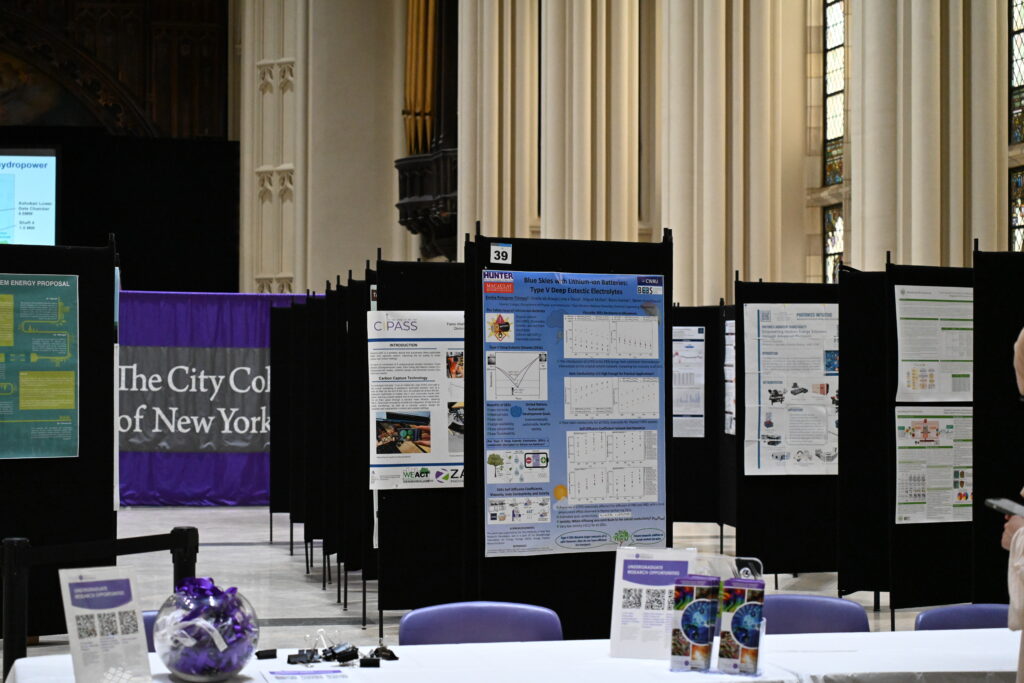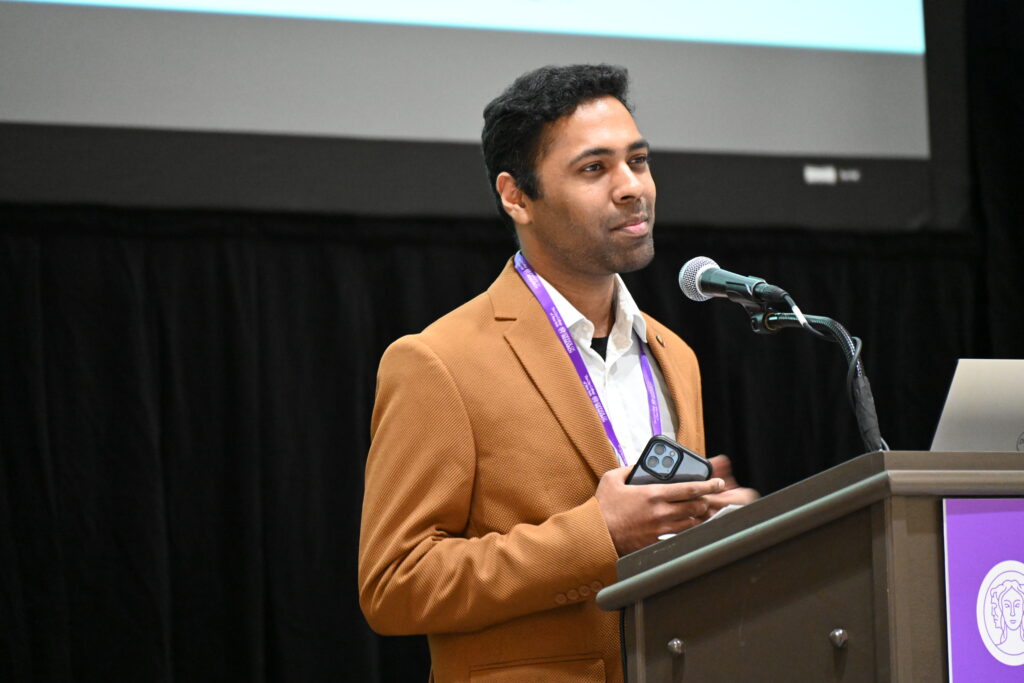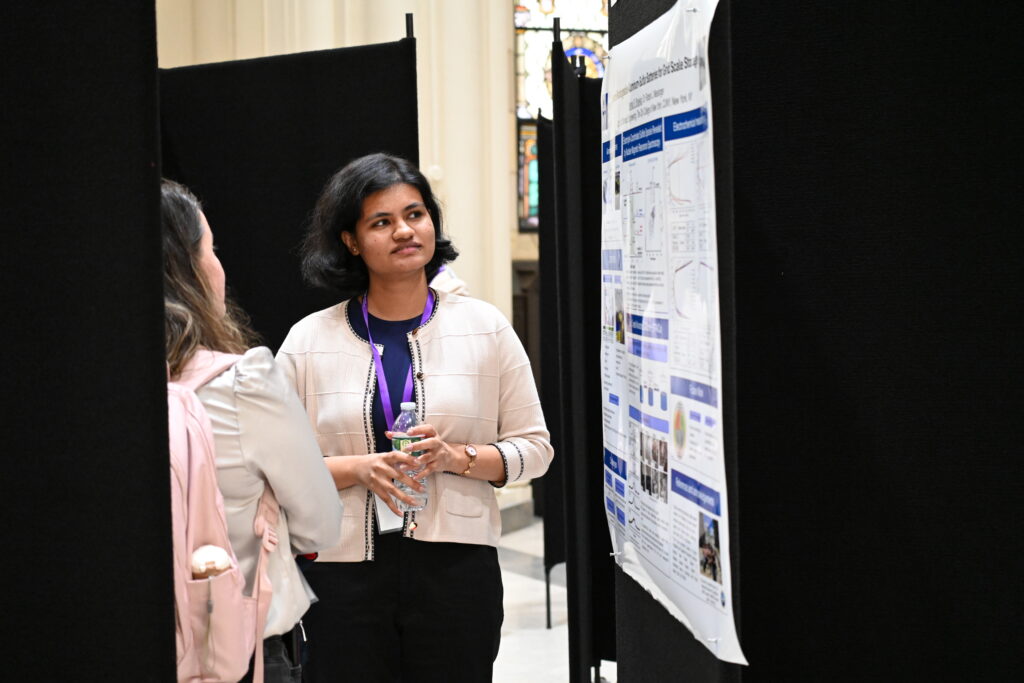Nearly 200 people gathered in Shepard Hall to attend City College’s first NYC Future Energy Conference on March 28.
While the demands of energy infrastructure are ever-changing in the face of climate change, the conference served as an event for innovators to come together to share their research related to the efficient distribution of energy and storage solutions.

Student posters at NYC Future Energy Conference
Students at City had the chance to show off their energy related research to conference attendees during the midday poster session.
Jatin Jain, an electrical engineering PhD student, was one of those students. He was also selected to present his research to attendees on the main stage.
Jain’s research centers around the technical and commercial aspects of virtual power plants. VPPs are decentralized power-generating units, such as wind turbines, solar panels and battery storage systems that function as one power plant.
While the different energy systems are not physically close together, they are connected through a cloud-based software. Jain is looking into how forming small groups of different types of distributed energy sources can provide grid stability and reduce reliance on a traditional central power plant.
On the commercial side of the research, Jain and his advisors, Dr. Ahmed Mohamed and Ondrea Kanwhen, are focused on using energy trading to maximize consumer profits.

Jatin Jain, an electrical engineering PhD student presenting his research to conference attendees
Looking at historical data sets from Berkeley Labs, specifically price-per-agreement sets in energy trades, energy prices are cheap, but consumers cannot maximize profits even though they are producing the energy and storing it.
This is due to the sale of energy typically involving an aggregator, a middle person who sells the energy to companies like Con Edison and Tesla.
The aggregator and companies make a profit, but the consumer does not, said Jain.
Jain and his team are using the historical data sets to forecast the prices of different energy sources using machine learning. That way the consumer can calculate how much energy needs to be sold to meet a certain revenue amount.
These trades will happen on Ethereum, a platform that uses blockchain technology for energy and trading transactions through smart contracts, self-executing contracts that execute automatically when the predefined conditions are met. This precludes the need for any central authorities.
Once the minimum price for the energy is set, those looking to purchase the energy can bid in an auction, maximizing consumer profits.
Patrick K. Yang, a fourth-year PhD student from the Chemistry Department, also presented his research.
With the help of his advisors, Dr. Sanjay Banerjee from the Chemical Engineering Department and Dr. Stephen O’Brien from the Chemistry Department, Yang’s research focuses on grid storage that is affordable, reliable and non-flammable.
Instead of the typically used lithium-ion batteries, Yang proposes using a zinc-based battery made with a water-based electrolyte, making it non-flammable.
Yang is also working on the utilization of a new material called calcium zincate. Using zincate as an additive, Yang and his team are making anodes with different amounts of zinc and calcium-zinc mixtures to see how they affect the battery’s performance and life cycle.
With the hope that grid storage can be built completely from calcium zincate, Yang is looking into the data, including the cost of the battery and materials.
Based on Yang’s research, when you increase the amount of calcium zincate in the anode, there is a fivefold increase in the cycle life.
There is a minimal increase in the cost of manufacturing calcium zincate, compared to traditional methods. Considering the cost in dollars per kilowatt hour over the cycle life, the initial higher investment in producing calcium zincate is offset by a reduction in the material costs per cycle as the quantity of calcium zincate increases.

Snehal Bhalekar, a PhD student from the Chemical Engineering Department presenting her research
Another student, Snehal Bhalekar, is also researching alternative energy storage solutions. The second year PhD student from the Chemical Engineering Department is focused on aluminum-sulfur batteries as a replacement for lithium batteries. Her advisor is Dr. Robert J. Messenger from the same department.
Bhalekar argues that aluminum is safer than lithium and it is easily recyclable. Aluminum-sulfur works as a pair, creating high energy storage capacity from relatively abundant and low-cost elements.

Malina Seenarine is a recent graduate of Baruch College where she studied journalism and minored in theater. In addition to writing for The RICC, she’s a contributor for Baruch’s award-winning Dollars & Sense Magazine and wrote for the arts and news section of Baruch’s student-run newspaper, The Ticker. She’s also written for FSR magazine.